AMD Ryzen 9 7950X vs Intel Core i9-13900K Face Off
Zen 4 vs Raptor Lake, Fight!

The Intel Core i9-13900K vs AMD Ryzen 9 7950X rivalry is a heated battle for supremacy at the top of the mainstream desktop PC market, with Intel's 13th-Gen Raptor Lake with an x86 hybrid architecture squaring off against AMD's chiplet-based Zen 4 Ryzen 7000 family. These two fundamentally different approaches have shaken up our list of the best CPUs for gaming, as the Intel vs AMD battle enters a new phase, but the competition is a bit closer than it might appear on the surface.
For Raptor Lake, Intel increased the number of E-cores across its product stack, thus technically giving the Core i9-13900K the lead in core counts — a first for Intel since Ryzen arrived back in 2017 — and improved the chips' clock rates and cache to boost performance.
AMD's Ryzen 7000 chips come to market with an entirely new architecture and process node. The company uses only full-fledged Zen 4 cores that benefit from a 13% increase in IPC, the TSMC 5nm process, vastly improved clock speeds, and a new AM5 platform that drastically improves power delivery to the cores. All told, the Ryzen 9 7950X represents a big step forward over the Zen 3 predecessors.
Both Ryzen 7000 and Raptor Lake's modern connectivity technologies bring big increases in throughput via DDR5 memory and PCIe 5.0 interfaces, but Intel also chose to continue to support DDR4 memory to offer a less-expensive path for builders. Meanwhile, AMD's decision to support only DDR5 has proven to be a pricing pain point.
Intel is also incredibly aggressive with pricing for its newest line. As a result, the $589 Core i9-13900K's pricing lands between the $699 Ryzen 9 7950X and the $549 Ryzen 9 7900X, but the Intel chip is incredibly competitive in all manner of work against the more expensive 7950X, not to mention having lower overall platform costs.
Below we've taken the Core i9-13900K vs Ryzen 9 7950X rivalry through a six-round faceoff to see which chip takes the crown in our gaming and application benchmarks, along with other key criteria like power consumption and pricing. Let's see how the chips stack up.
Features and Specifications: Intel Core i9-13900K vs Ryzen 9 7950X
| Row 0 - Cell 0 | Price | Cores / Threads (P+E) | P-Core Base/Boost (GHz) | E-Core Base/Boost (GHz) | Cache (L2/L3) | TDP-PBP / MTP | Memory |
| Ryzen 9 7950X | $699 | 16 / 32 | 4.5 / 5.7 | - | 80MB (16+64) | 170W / 230W | DDR5-5200 |
| Core i9-13900K / KF | $589 (K) - $564 (KF) | 24 / 32 (8+16) | 3.0 / 5.8 | 2.2 / 4.3 | 68MB (32+36) | 125W / 253W | DDR4-3200 / DDR5-5600 |
The 13900K faces off with two AMD chips: The $699 sixteen-core 32-thread Ryzen 9 7950X and the $549 twelve-core, 24-thread Ryzen 9 7900X. However, the 7900X trails the 13900K in every category by large margins, and its price-to-performance ratio isn't competitive. As such, we'll focus on the 13900K vs 7950X comparison for this article. AMD is currently running a holiday promotion, meaning this isn't a permanent price cut for the Ryzen 9 7950X. The chip is currently down to $574 at some retailers. As always, we use standard suggested pricing for our comparisons because sales are sporadic, and competing chips can also go on sale. However, you should keep this in mind and make sure to check current pricing.
Intel still uses the 'Intel 7' process node for Raptor Lake but leveraged a newer revision of the silicon (the fifth) to push clock speeds higher while improving power efficiency. Intel's $589 sixteen-core Core i9-13900K comes with eight hyper-threaded P-cores and 16 single-threaded E-cores, for a total of 32 threads. That's an increase of eight additional E-cores over the previous-gen Core i9-12900K, which equates to much more threaded horsepower. The P-cores come with a 3.0 GHz base (a 200 MHz decline), but, more importantly, a 5.8 GHz boost that represents a whopping 600 MHz increase over the prior gen. Meanwhile, the E-cores now have a 3.0 GHz base (+600 MHz) and stretch up to 4.3 GHz (+400 MHz), meaning that not only do you get more E-cores, but you also get more out of each core.
The 13900K is also equipped with 32MB of L3 cache and 36MB of L2 (+18MB) and drops into existing 600-series motherboards or the new 700-series models. The chip comes with the integrated UHD Graphics 770 engine with 32 EUs that boost up to 1.65 GHz. You can also save some cash with the Core i9-13900KF, which is identical but lacks the Intel UHD Graphics 770 engine, for $564.
Intel's chips now have a Processor Base Power (PBP) value in place of TDP, and a secondary Maximum Turbo Power (MTP) value that denotes the highest power level during boost activity. The 13900K comes with 125W PBP (base) and 253W MTP (peak) power ratings, but be aware that Intel's default boost duration for all K-series chips is unlimited. This means the chip can always operate at the 253W MTP when it is under load, though the actual power use will vary with application intensity.
The 13900K also has Adaptive Boost Technology (ABT), which dynamically boosts to higher all-core frequencies based on available thermal headroom and electrical conditions. If the ABT algorithm sees that the chip is below 100C during heavy workloads, it will increase performance and power consumption until the processor reaches the safe 100C limit, thus providing more performance.
AMD etches the $699 Ryzen 9 7950X on the TSMC 5nm process. The chip comes with a 4.5 GHz base (+1.1 GHz) and 5.7 GHz boost (800 MHz), with the latter being the highest boost frequency we've seen with any Ryzen processor. AMD's new AM5 platform has significantly improved power delivery which allows the company to extract more performance during taxing multi-core workloads. Notably, the Ryzen 9 7950X supports hardware acceleration of AVX-512 instructions, whereas the 13900K does not.
That has an effect, though — the 7950X chip has a 170W TDP rating and a max power draw of 230W, the highest power consumption of any Ryzen chip yet. It's also much higher than the previous-gen Ryzen 9 5950X's 105W TDP rating. As we see with Intel's chip, the 7950X is designed to use the full thermal headroom available to deliver more performance. However, the 7950X has a lower 95C thermal limit, so it will frequently operate at 95C while under heavy load.
The AM5 platform also marks the company's first LGA socket in recent history and comes with support for DDR5-5200 memory and the PCIe 5.0 interface, allowing the company to largely match Intel on the connectivity front. However, AMD's AM5 platform supports only DDR5 memory, while Intel's 600- and 700-series chipsets support both DDR5-5600 and DDR4-3200. AMD's decision to go all-in on DDR5 is one of the key reasons why its platform costs are so much higher than Intel's — DDR5 still carries premium pricing but doesn't deliver large performance gains over DDR4 in most types of work, including gaming. The AM5 platform is new, so the chips aren't backward compatible with older AM4 motherboards. AMD will support AM5 until 2025+, meaning it should have an extended pathway for upgrades.
AMD has moved forward in another key area — the 7000 series marks the arrival of an integrated GPU for all of the mainstream Ryzen processors, an area that had been sorely lacking in the past. The RDNA 2 iGPU is designed to provide basic display output capabilities, and AMD says you shouldn’t expect it to support any meaningful gaming. The RDNA 2 iGPU comes with two compute units, 4 ACE, and 1 HWS. In either case, this is an important step forward for AMD's chips, as it helps in the OEM market and gives you an option to simply power a display or do troubleshooting if you have an issue with a discrete GPU.
Winner: Tie
The Intel Core i9-13900K vs AMD Ryzen 9 7950X battle yields a tie in the features and specifications category. For connectivity, both chips support DDR5 and the PCIe 5.0 interface, meaning that neither chip has an inherent advantage over the other in the underlying connectivity technology. However, Intel has the advantage of backward compatibility for DDR4, enabling lower-cost motherboards and memory for value seekers.
While AMD's new AM5 platform only supports pricey DDR5 and carries a premium over the Intel motherboard ecosystem, it does afford forward compatibility — AMD plans on supporting the AM5 platform until 2025+. Meanwhile, Raptor Lake drops into previous-gen 600-series motherboards, providing a value option if the board has the correct BIOS, but the newer 700-series motherboards represent the end of the line for the LGA 1700 socket. That means the chips won't be forward-compatible.
Given its new hybrid architecture with two types of cores, Intel's core counts aren't directly comparable to AMD's due to their different capabilities. Our performance results will dictate the value of the overall designs.
Gaming Benchmarks and Performance: Intel Core i9-13900K vs Ryzen 9 7950X
Remember, this article is an overview of our much more in-depth testing in our Intel Core i9-13900K and Core i5-13600K Review. Below you can see the geometric mean of our gaming tests with the Core i9-13900K vs the Ryzen 9 7950X at 1080p and 1440p, with each resolution split into its own chart. As per usual, we're testing with an Nvidia GeForce RTX 4090 to reduce GPU-imposed bottlenecks as much as possible, and differences between test subjects will shrink with lesser cards or higher resolutions.




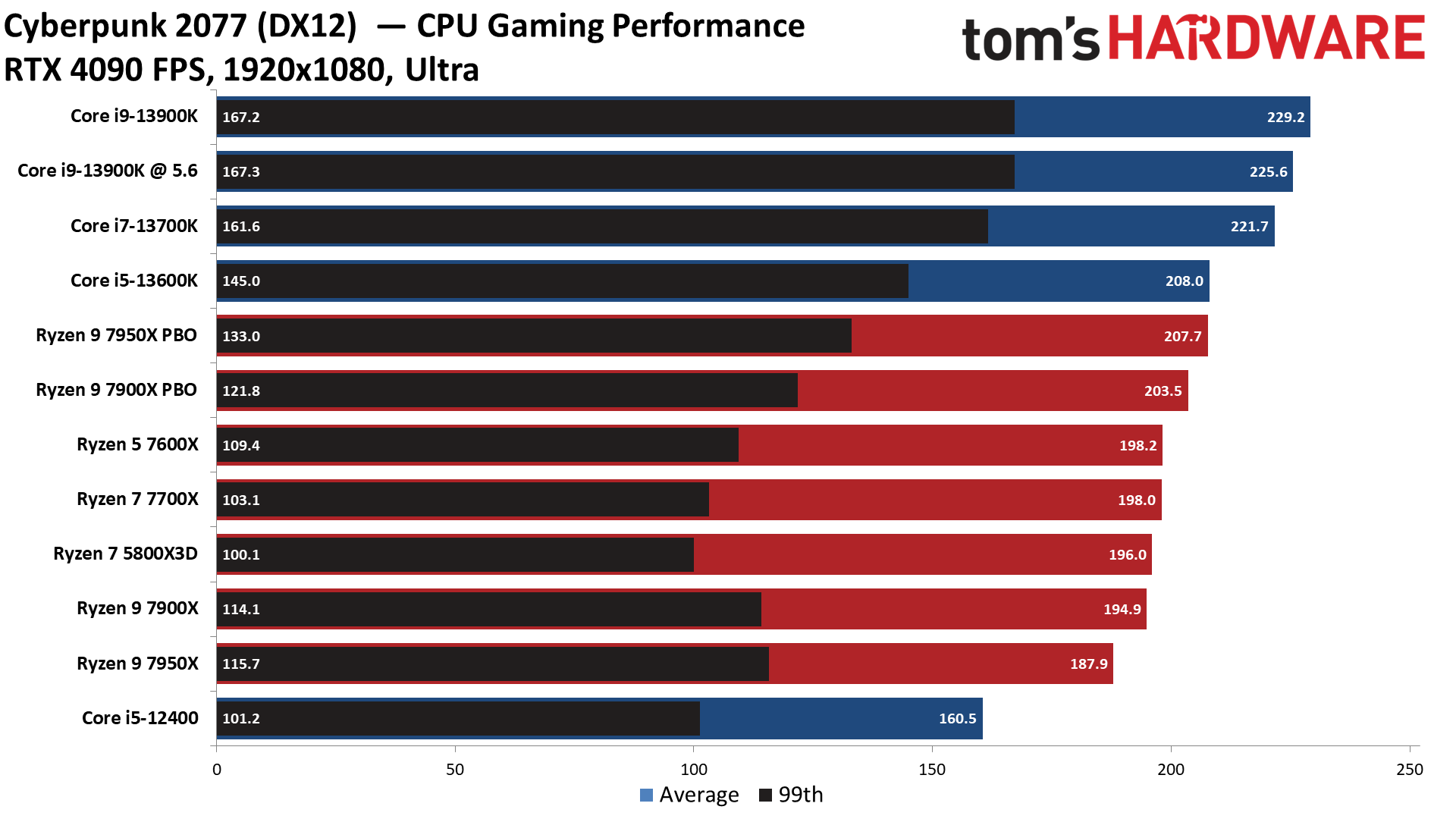

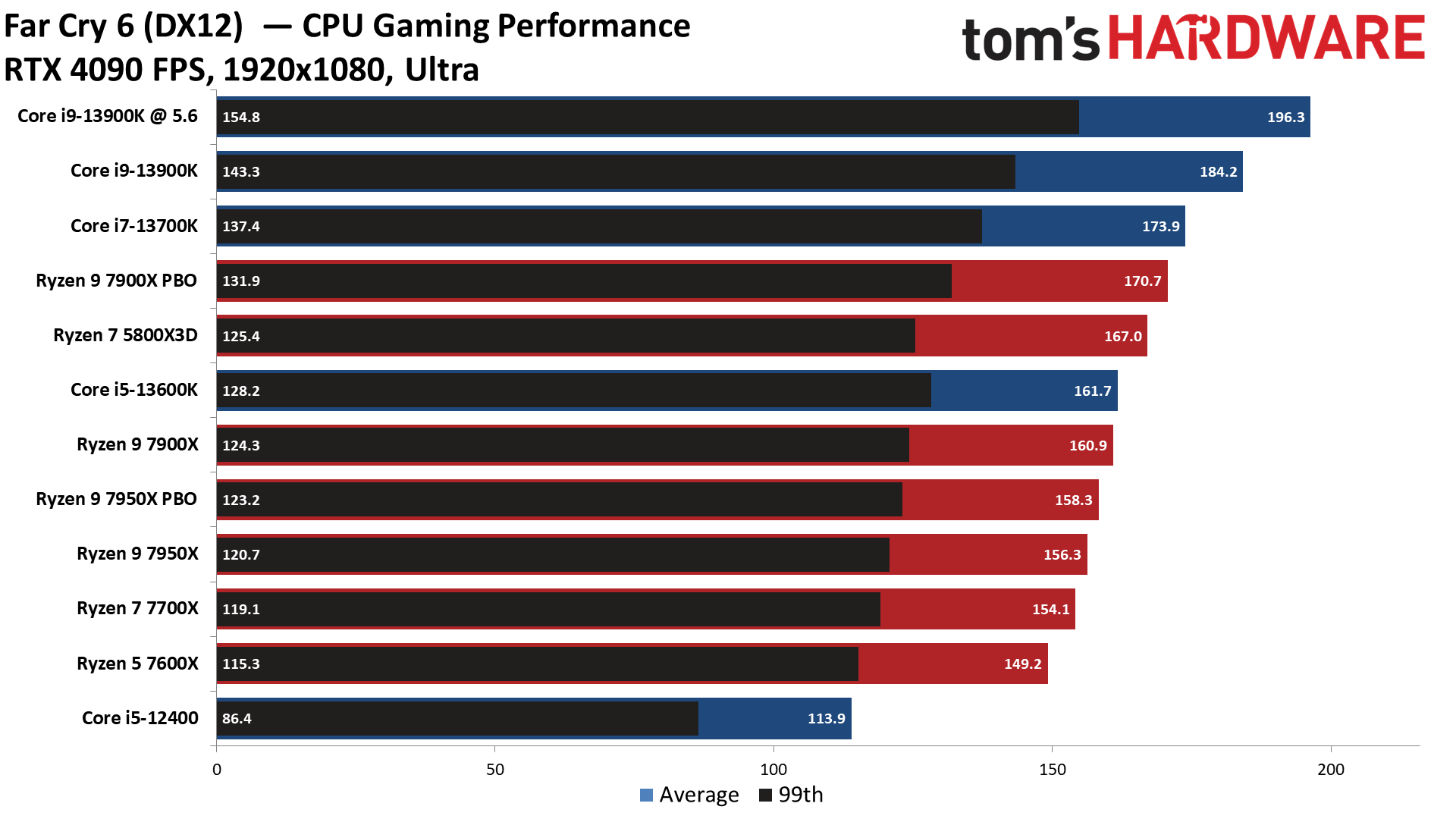




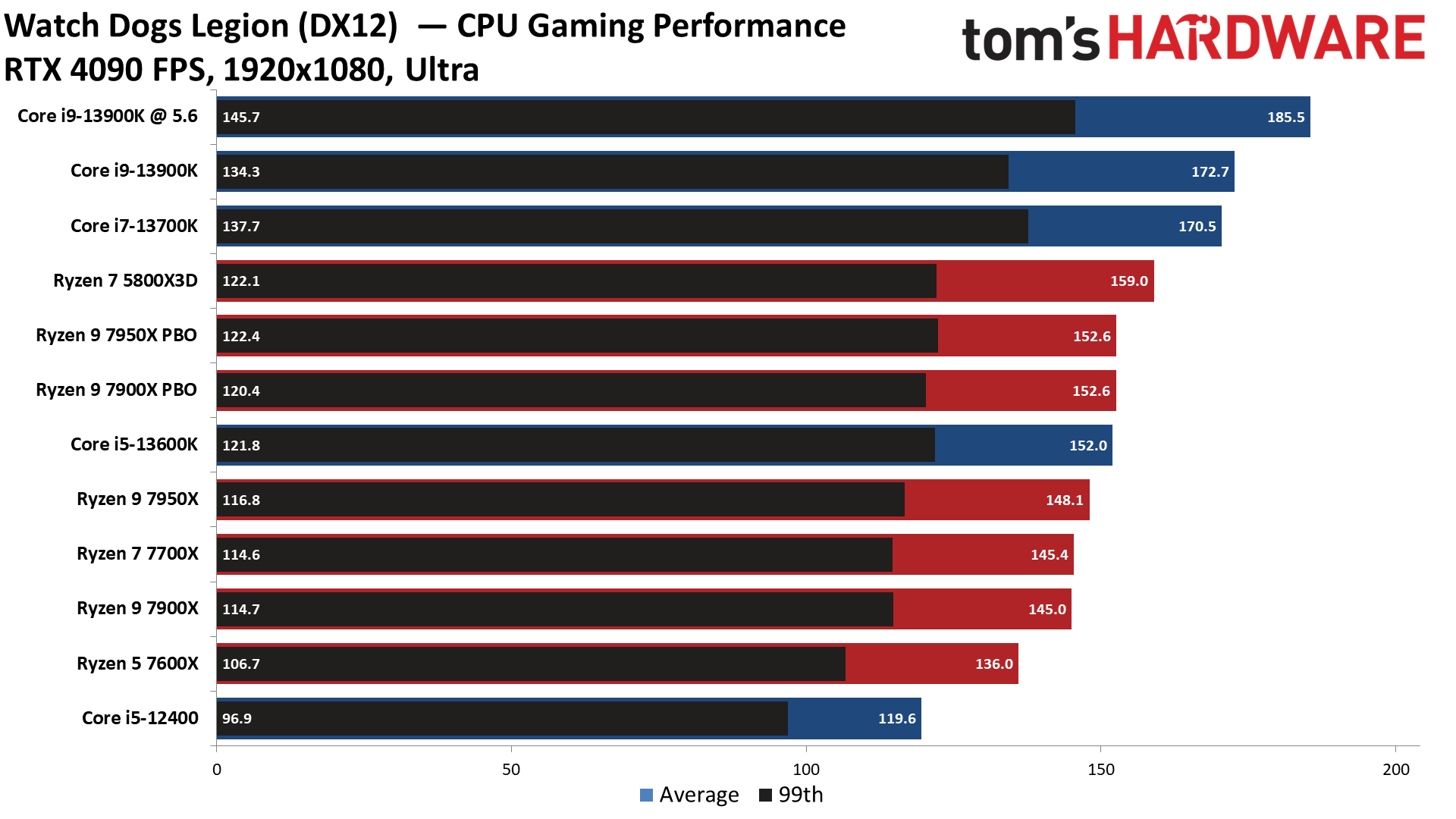
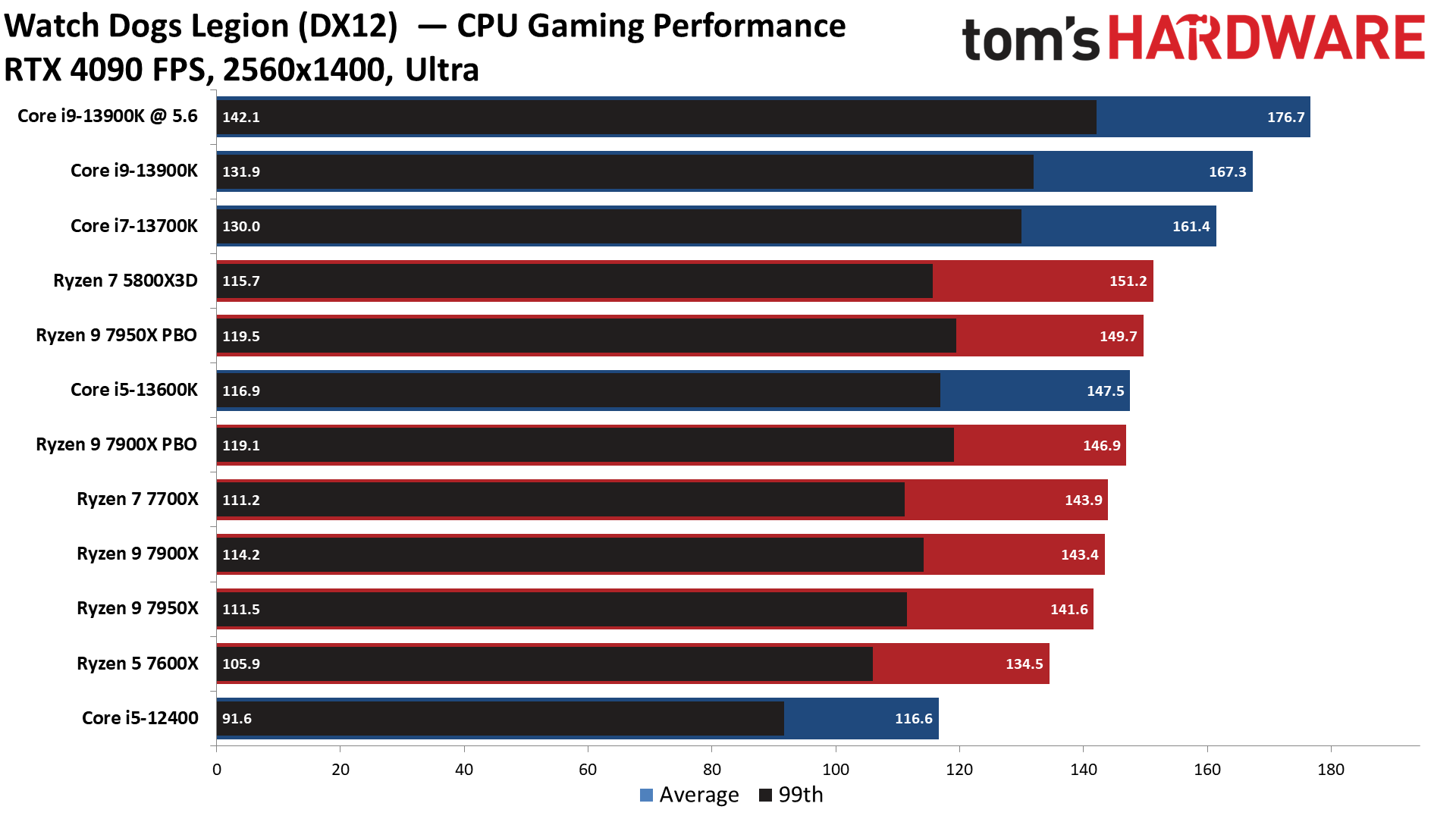





The $589 Core i9-13900K is 15% faster than the $699 Ryzen 9 7950X in our 1080p gaming suite, which isn't a small delta. Also, the Ryzen 9 and 7 series of chips offer roughly the same gaming performance, with a mere two fps separating the three most powerful models, so the 13900K beats the entire Ryzen lineup by an appreciable amount. Notably, if you opt for DDR4 with the 13900K, you'll lose roughly ~4% of performance, on average (see our testing here).
The Core i9-13900K also has impressive overclocking headroom that pushes the chip to 5.6 GHz, while the Ryzen 9 7950X is best overclocked using the auto-tuning Precision Boost Overdrive (PBO) feature. After overclocking, the 13900K is 13% faster than the overclocked Ryzen 9 7950X.
Moving over to 1440p pushes the bottleneck more towards the GPU, so the difference between the chips shrinks. However, the RTX 4090 has lots of performance headroom, so the deltas between 1080p and 1440p aren't as high as we're accustomed to. For example, at 1440p, the 13900K is 11% faster than the Ryzen 9 7950X at stock and 10% faster after tuning both chips.
AMD's fastest gaming chip comes in the form of the previous-gen $430 Ryzen 7 5800X3D, but the Core i9-13900K is 4% faster. Additionally, unlike the 5800X3D, the 13900K offers a much more balanced profile that doesn't result in tradeoffs in applications, either. Notably, moving to 1440p shrinks the delta between the two chips to a few percentage points. However, be aware that the Ryzen 7 5800X3D doesn't accelerate all game titles equally, so be sure to do your research. AMD does have its Ryzen 7000 X3D models coming to market, which could change the pecking order.
Flipping through the 99th percentile charts (a good indicator of smoothness) shows larger deltas between the chips, with the Core i9-13900K taking a 20% lead over the Ryzen 9 7950X at stock, and a 16% lead after overclocking.
Be aware that large deltas in individual game titles, as we see with the 5800X3D, impact cumulative measurements. The Nvidia RTX 4090 delivers the largest gen-on-gen increase in GPU compute power in recent history, so we could see a wave of game optimizations to fully exploit the increased resources. That means these results could change, and as always, the AMD vs Intel competition can vary based on the title and the GPU you use, so it's best to make an informed decision based on the types of titles you play frequently. Be sure to check out the individual tests in the above album.
Winner: Intel
The Core i9-13900K is faster than the Ryzen 9 7950X in gaming at both 1080p and 1440p resolutions by 15% and 11%, respectively. It also has an appreciable advantage when we take 99th percentile frame rate measurements into account. At the end of the day, the Core i9-13900K is simply the fastest gaming chip money can buy.
As always, we don't recommend chips in this price range if you're only interested in gaming, but the Core i9-13900K is the fastest gaming chip money can buy. Also, it's possible that the Ryzen 7000 X3D models with vertically-stacked L3 cache could take the lead when they come to market. Intel also has a 6 GHz special edition coming soon, too.
Productivity Performance: Intel Core i9-13900K vs Ryzen 9 7950X
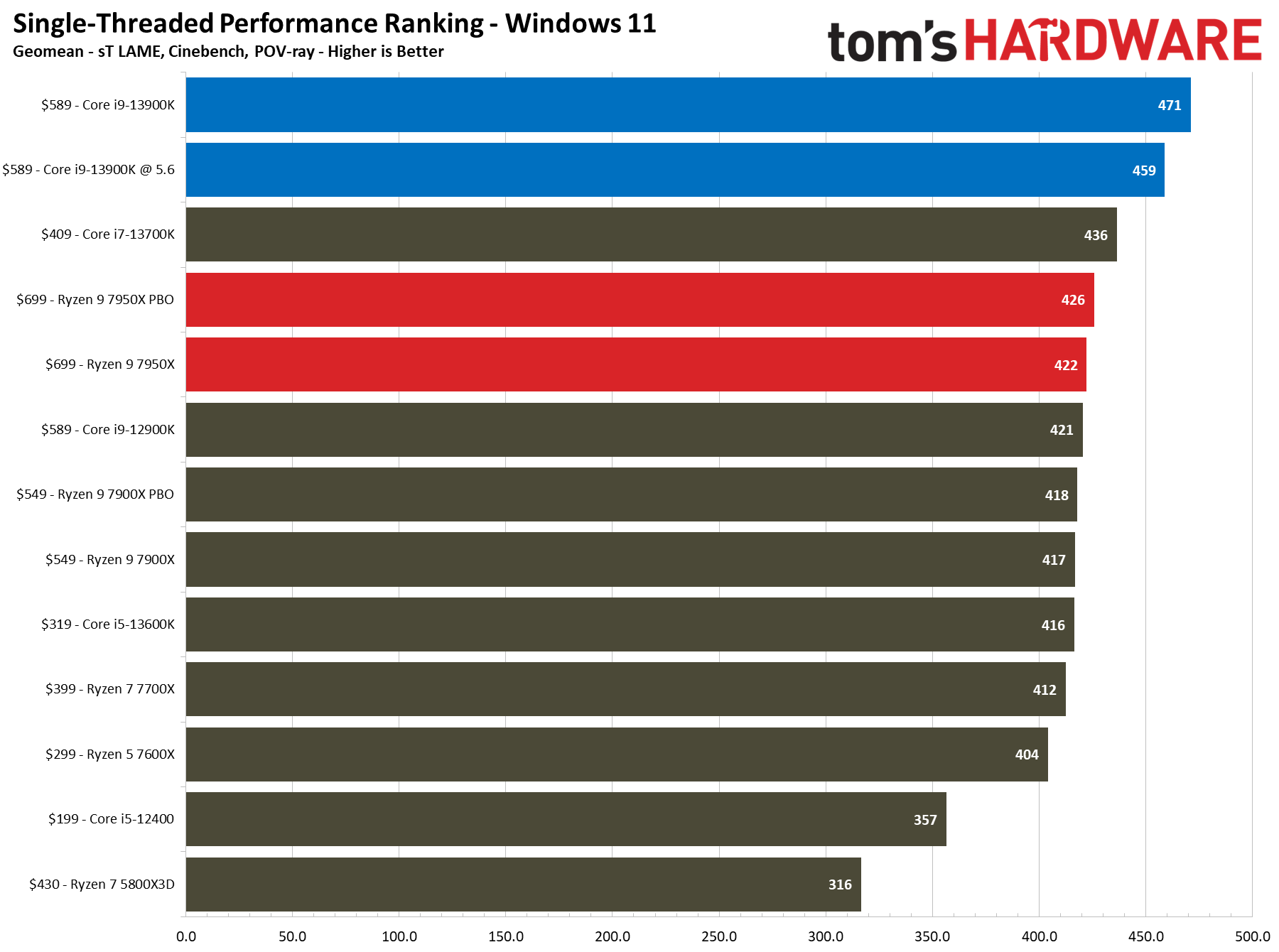




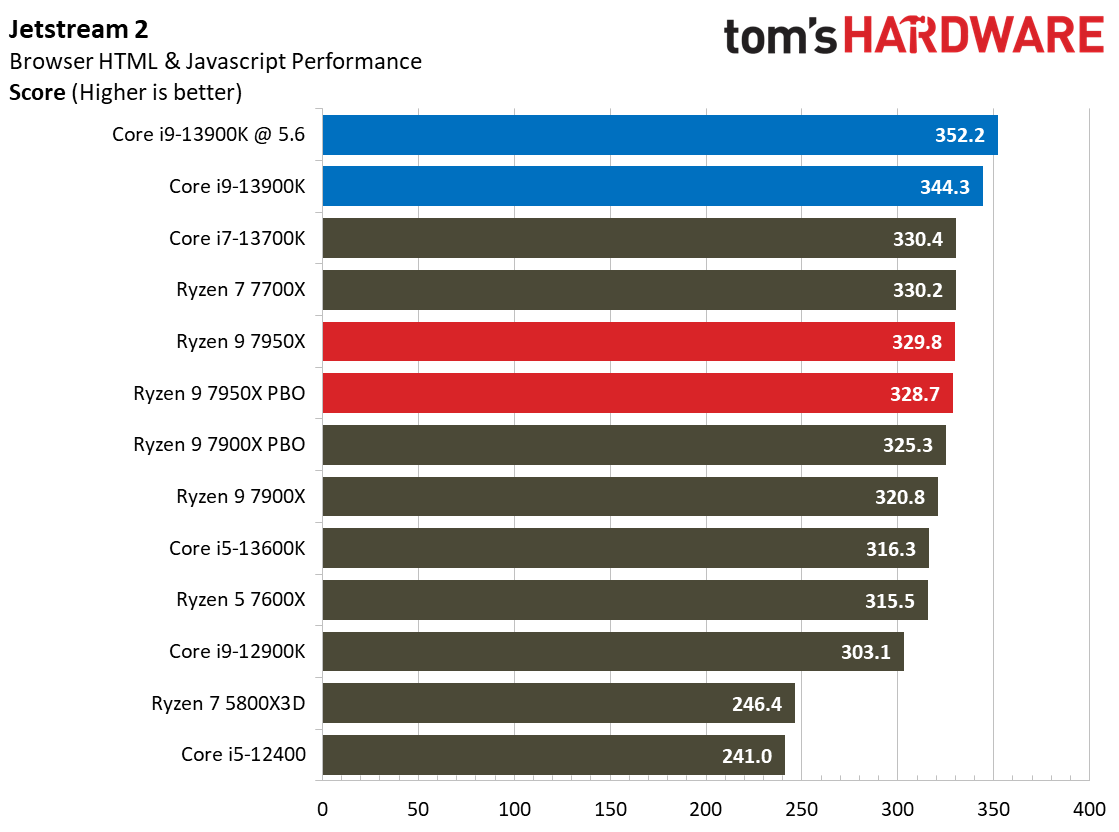






We can boil down productivity application performance into two broad categories: single- and multi-threaded. The first slide above shows the geometric mean of performance in several of our most important tests in each category, but be sure to look at the expanded results below.
Get Tom's Hardware's best news and in-depth reviews, straight to your inbox.
The deltas in favor of the Core i9-13900K are convincing in the overall measure of single-threaded performance — the Core i9-13900K is 8% faster than the Ryzen 9 7950X at stock settings and 11% faster after overclocking. Overall, the Core i9-13900K has the fastest single-threaded performance on the market.
Naturally, those performance deltas won't carry over to every type of workload. Flipping through the album of test results reveals that the Core i9-13900K vs Ryzen 9 7950X competition can be close in this type of work, and the Ryzen 9 7950X leads in the AVX-512 y-cruncher benchmark.
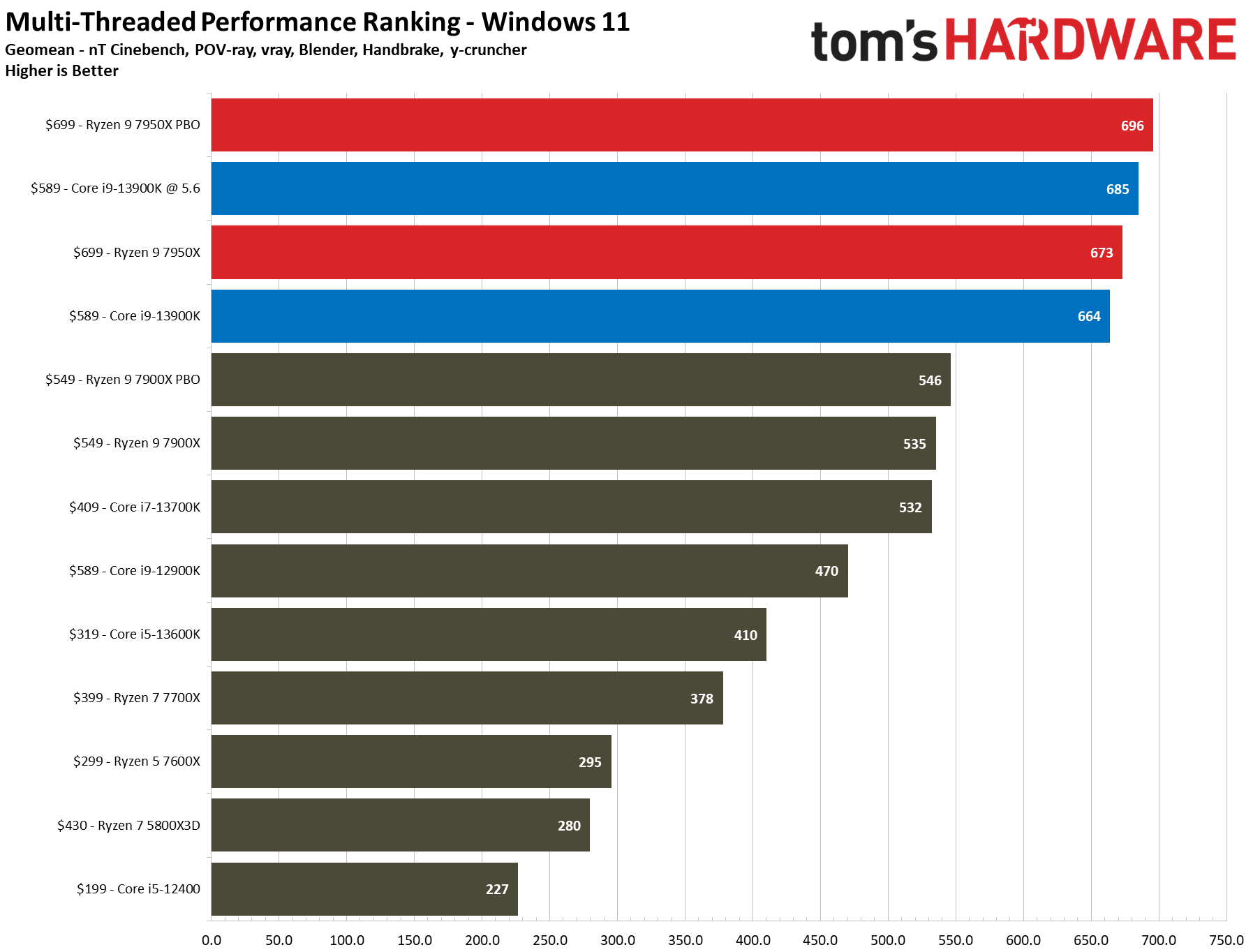

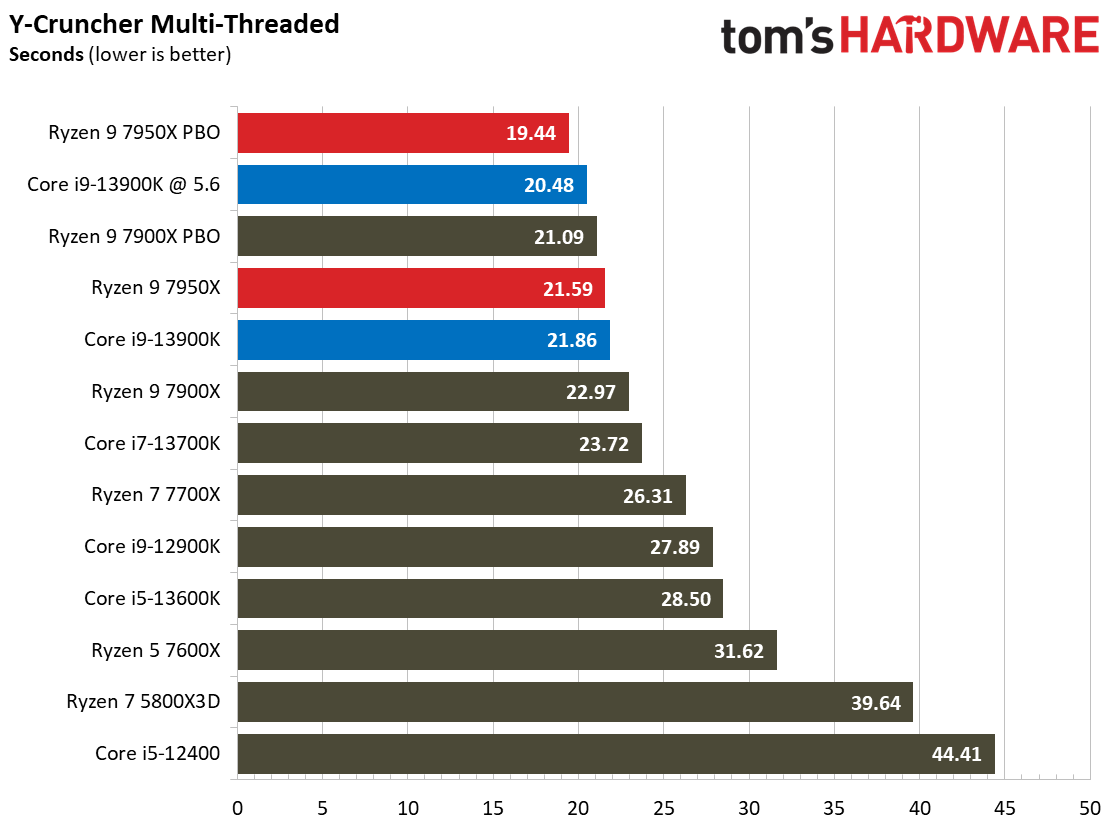

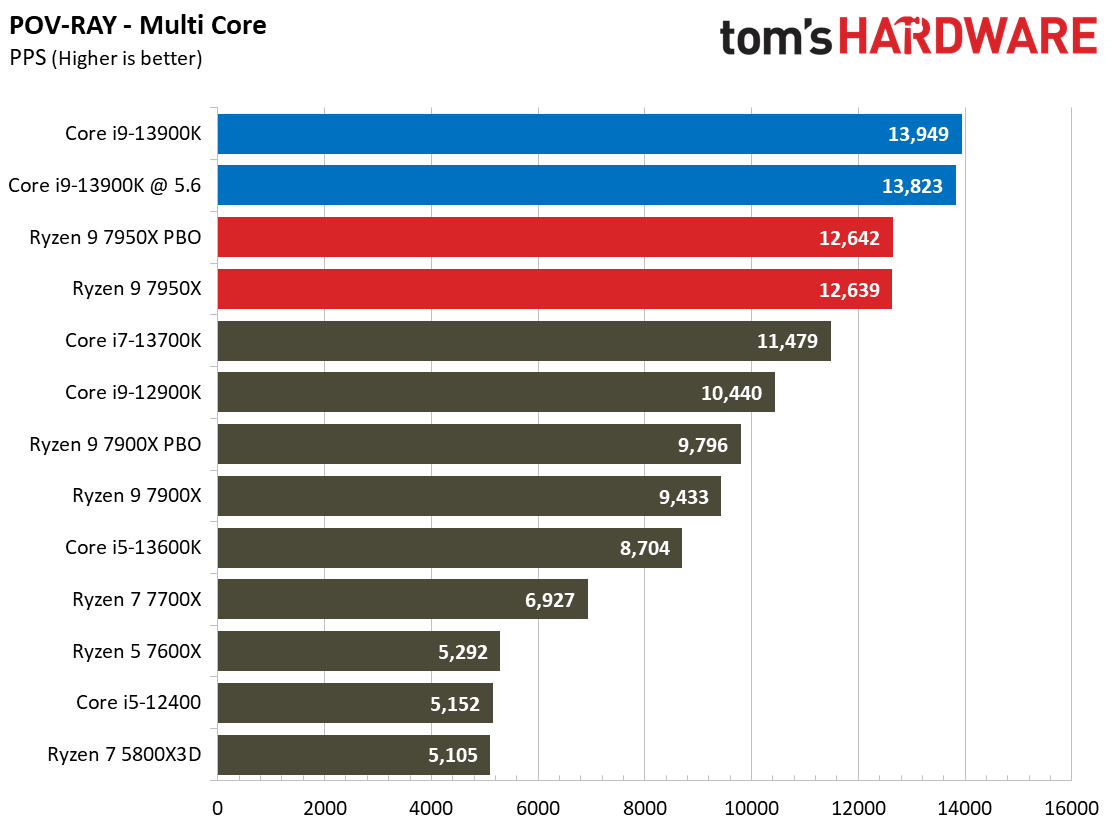




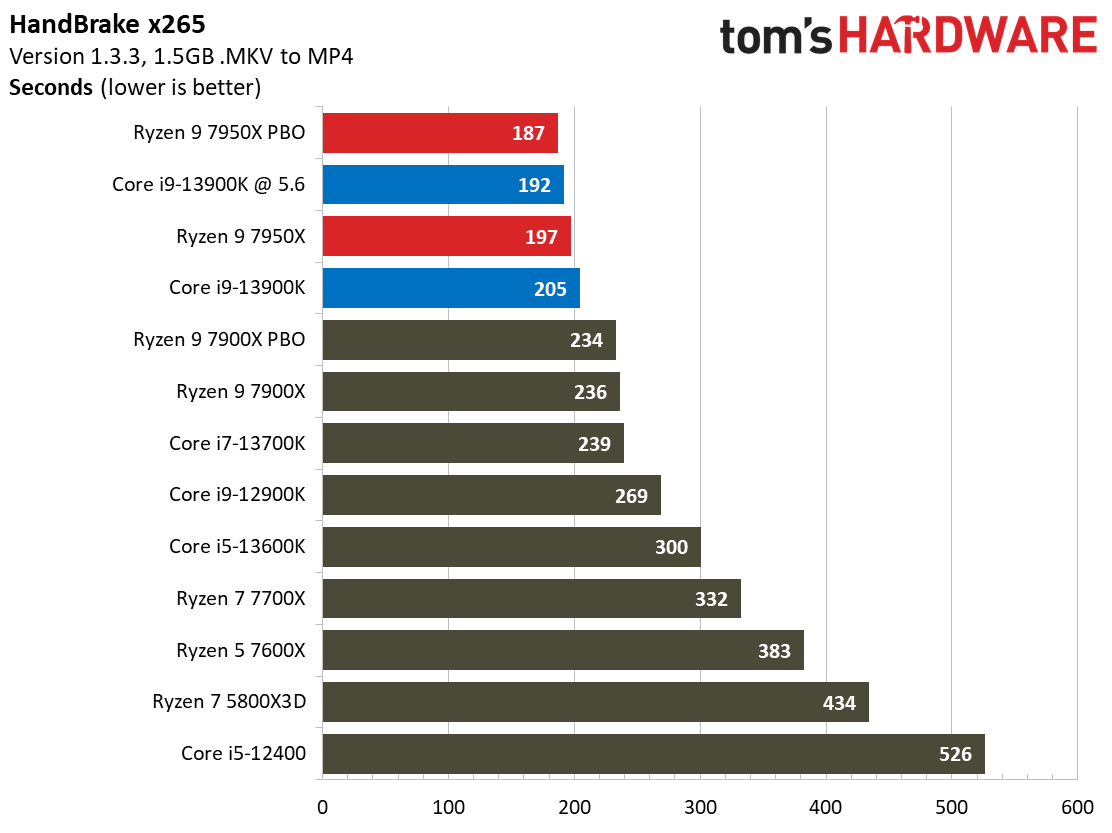









The $699 Ryzen 9 7950X is roughly 1.5% faster than the $589 Core i9-13900K in multi-threaded workloads at both stock and overclocked settings, which is close enough to consider a tie. Therefore, if you're heavily focused on productivity, the best solution could boil down to the types of applications you use most.
For instance, the Ryzen 9 7950X tends to lead in workloads that heavily favor AVX throughput, like Blender and y-cruncher, while the 13900K holds the advantage in Cinebench and some applications with branchy code, like compilation.
Winner: Tie
The Intel Core i9-13900K leads in single-threaded workloads. It also effectively ties the Ryzen 9 7950X in multi-threaded workloads, with relatively small deltas between the two in threaded work varying based on the workload. However, AMD's Ryzen 7000 uses hardware acceleration to speed AVX-512 workloads, a tangible advantage over Raptor Lake in an increasing number of heavily-threaded tasks, yielding a tie in this section.
Overclocking: Intel Core i9-13900K vs Ryzen 9 7950X
We have long since reached the land of diminishing returns for overclocking the highest-end chips from AMD and Intel, including the Ryzen 9 7950X and Core i9-13900K. Because AMD has pulled Intel into a dogfight for performance superiority on the high end, much of the overclocking frequency headroom is rolled into standard stock performance. As a result, you'll find larger overclocking gains with the downstream models.
Intel and AMD expose a wealth of tunable parameters and sophisticated software overclocking utilities like XTU and Ryzen Master. They also support per-core frequency and hyper-threading control (enable/disable) to help eke out more overclocking headroom.
| Overclocking %age gain over stock | Ryzen 9 7950X PBO, DDR5-6000 | Core i9-13900K @ 5.6 GHz, DDR5-6800 |
| Gaming | 5% | 2.9% |
| Single-Threaded | 1% | 2.6% |
| Multi-Threaded | 3.4% | 3.2% |
As you can see above, overclocking both the memory and the cores only grants small gains for both chips, and the small difference in overall performance gains could merely boil down to your luck in the silicon lottery.
Intel has long restricted overclocking to its pricey K-series models, while AMD freely allows overclocking with all SKUs on almost any platform. However, we see some improvement here from Intel, as it has now enabled memory overclocking on its B- and H-series chipsets.
The 7950X and 13900K come with innovative boost technology that largely consumes most of the available frequency headroom, though Intel does have room for higher all-core overclocks. Unfortunately, all-core overclocking with AMD's chips is lackluster; you're often better off using its auto-overclocking Precision Boost Overdrive 2 (PBO2) feature that boosts multi-threaded performance. AMD also has plenty of Curve Optimization features that leverage undervolting to increase boost activity.
Intel's Raptor Lake chips are constrained by heat output — we obtained a 5.6 GHz overclock on the P-cores and a 4.4 GHz overclock on the E-cores, but we've seen that 5.7 GHz is common with 360mm AIOs or custom watercooling setups. We're sure a better cooler would allow us to push even further, but we stuck with our standard cooling setup (280mm AIO) to represent what a regular user could easily achieve.
Winner: Tie
Both platforms have a wealth of tunable parameters for enthusiasts, their respective overclocking advantages, and a suite of auto-overclocking and software utilities. Dedicated tuners could find larger performance boosts by overclocking the core, fabric, and memory more aggressively than we have. However, on the high end, most of the overclocking headroom has been rolled right into the out-of-the-box performance of the chip.
Both companies have their advantages: Intel has the highest peak overclocking frequencies we've ever seen but restricts full overclockability to K-series chips and Z-series motherboards. AMD allows overclocking on all but its X3D model and A-series motherboards but has lower peak frequencies. That means this contest will often boil down to personal preference.
Power Consumption, Efficiency, and Cooling: Intel Core i9-13900K vs Ryzen 9 7950X



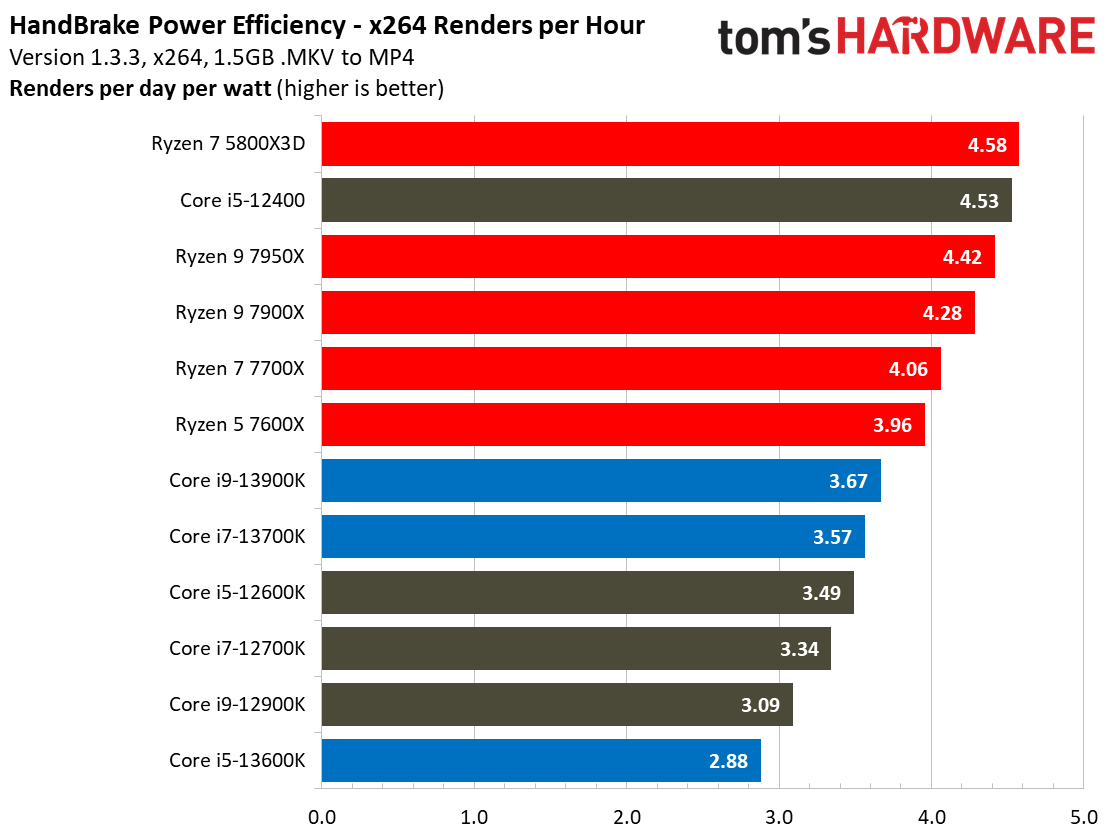



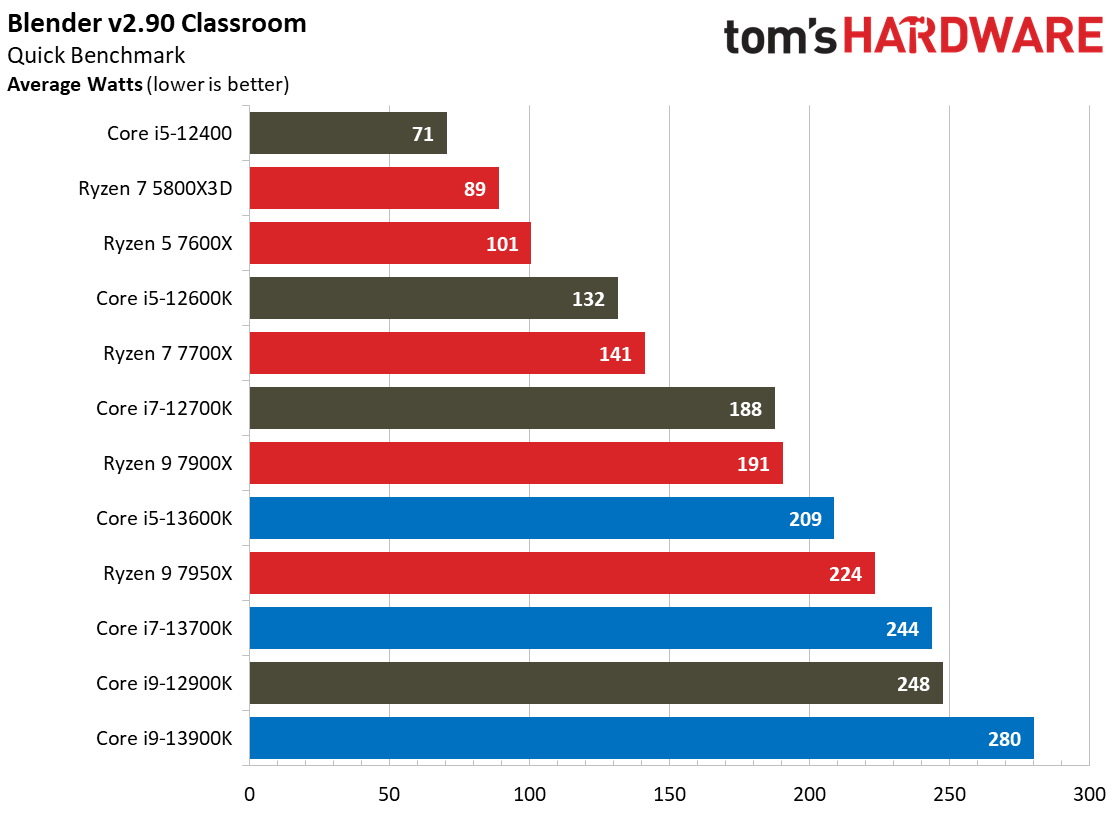



AMD has cranked up its power consumption to keep Ryzen 7000 competitive, but Raptor Lake still sucks more power. Overall, the Zen 4 architecture paired with the TSMC 5nm process is more efficient than Intel's fifth revision of the 'Intel 7' process and the x86 hybrid architecture.
Raptor Lake consumes more power than Alder Lake, but it is also much faster than its predecessor, earning it some leeway. As we see in our renders-per-day measurements, the 13900K still takes a step forward with better power efficiency than the previous-gen 12900K. However, AMD still holds the advantage in all key power criteria.
Both chips are designed to run at their maximum rated thermal specification (100C for Intel, 95C for AMD) during heavy workloads, so you shouldn't be surprised to see them run at these elevated temperatures even when they are paired with the recommended 280mm AIO (or air equivalent) for Intel, or 240mm AIO (or air equivalent) for AMD. However, Intel's system consumes more power, resulting in higher thermal output.
Winner: AMD
Intel has made plenty of progress, but AMD still holds the crown of the most power-efficient chips. Not only do they suck less peak power, but they also accomplish more work per unit of power consumed. That results in an overall win in power consumption, efficiency, and thermal output, so you'll end up with a cooler and quieter system.
Neither of the chips in our AMD Ryzen 9 7950X vs Intel Core i9-13900K faceoff comes with a bundled cooler, but Raptor Lake's higher power consumption means you'll need a beefier cooler to contain the Core i9-13900K than you will for the Ryzen 9 7950X.
Pricing: Intel Core i9-13900K vs Ryzen 9 7950X
The Core i9-13900K has impressive performance for its $598 price tag, and you can even go graphics-less to save some cash with the $564 Core i9-13900KF model. That's exceptionally competitive pricing against AMD's $699 Ryzen 9 7950X that it rivals or beats in all but power consumption metrics.
However, AMD has begun what it tells us is a holiday promotion, meaning this isn't a permanent price cut for the Ryzen 9 7950X. The chip is currently down to $574 at some retailers, which would change these calculations quite a bit. If you're planning on building a DDR5 system only and aren't interested in the utmost performance in gaming, then the Ryzen 9 7950X might be a better buy if the Intel processors aren't also on sale. As always, we use standard suggested pricing because sales are sporadic, and competing chips can also go on sale. However, you should keep this in mind and make sure to account for current pricing.
Despite that Black Friday sale, the Ryzen 9 7950X does face other challenges that come in the form of high memory and motherboard pricing. We dove in deep on those issues here, but here are a few examples.
| Z790 and X670E | Intel | AMD | Difference |
| Asus | $629 — Z790 Hero | $699 — Crosshair X670E Hero | $70 — 11% |
| ASRock | $479 — Z790 Taichi | $499 — X670E Taichi | $20 — 4% |
| MSI | $1,19 — Z790 Godlike9 | $1,240 — X670E Godlike | $41 — 3% |
| Row 4 - Cell 0 | B650 and B660 | Row 4 - Cell 2 | Row 4 - Cell 3 |
| MSI | $169 — B660M Mortar WIFI DDR4 | $239 — B650M Mortar WIFI | $70 — 34% |
| Gigabyte | $149 — B660M Pro AX DDR4 | $199 — B650M Pro AX | $50 — 33% |
| Asus | $208 — B660-A Gaming WIFI DDR4 | $280 — ROG B650-A Gaming WIFI | $72 — 34% |
| MSI | $188 — B660M Mortar WIFI DDR5 | $239 — B650M Mortar WIFI | $51 — 24% |
| Asus | $199 - B660-I Gaming WiFI DDR5 | $280 — ROG B650-A Gaming WIFI | $80 — 33% |
Platform pricing comes into play when you're making a purchasing decision, so here’s a pricing breakdown for Z790 vs X670E motherboards, along with the B650 vs B660 comparisons.
Intel’s Z790 platform is generally less expensive than AMD's X670E, but the margins are fairly small, ranging from the same price to 11%. In absolute terms, that means you’ll pay as much as $70 more for an X670E Hero, for instance. We do expect most Ryzen 9 7950X users to pair the chip with a higher-end board, so the higher-end Z790 and X670E are the most relevant comparison points.
However, it is noteworthy that pairing an upper-tier Intel chip with a lower-end board can result in lower performance due to lesser power delivery, though this varies by the motherboard. In contrast, AMD's higher TDP rating means that the lower-end B-series boards should have more robust power circuitry that might not hamstring performance as much — be sure to check reviews.
There are more savings to be had with Team Blue with DDR4 Z790 boards. Support for DDR5 requires more complex motherboard designs with better materials, which adds cost. So while DDR4 costs less and offers nearly the same performance, it also provides a pathway to lower-priced motherboards. On average, you’ll often pay $20 to $30 less for a DDR4 Z790 board, but you won’t have the option to drop to these lower-tier-memory motherboards with Ryzen.
Additionally, the pricing advantage of DDR4 is simply too much to ignore. While the premium for DDR5 has receded, you’ll still pay up to twice as much for a DDR5 kit as for DDR4, and AMD doesn't support the latter. For Raptor Lake, the slim performance advantage of DDR5 certainly doesn’t justify the extra price for DDR4, at least not for most users. Additionally, perhaps the best memory kit is the one you don’t have to buy — many upgraders likely already have a DDR4 kit, which is a plus.
Winner: Intel
AMD's Ryzen 7000 chips have much higher suggested pricing than Intel's Raptor Lake, but we do have to consider that there are currently Black Friday deals that make the Ryzen 9 7950X much more competitive against the Core i9-13900K. AMD has told us that these sales are holiday specials, and we might see Intel respond with its own sales. As such, we stick to official pricing for this comparison.
Looking through the prism of the official recommended pricing, the Ryzen 9 7950X at $699 is overpriced compared to the $589 Core i9-13900K. The Core i9-13900K beats the 7950X in gaming and single-threaded performance, while essentially tying it in multi-threaded performance. AMD does have better power consumption metrics and the benefit of a forward-looking AM5 platform, while Intel's LGA 1700 is a dead-end platform. For most users, that isn't enough to offset the higher pricing you'll pay today.
Additionally, Ryzen 7000 faces its biggest challenges in other areas, like motherboard and memory pricing. We have seen pricing for the high-end X670E motherboards improve over time, so they typically only carry a small premium over DDR5-supporting Z790 motherboards. However, you can save an additional $20 to $30 for a DDR4 Z790 motherboard, but you don't have that option for AMD's 7000 series.
Finally, DDR5 memory continues to carry a premium over DDR4, another factor that gives Intel builders an additional path for lower-priced builds. However, it does come at the cost of a negligible difference in application performance and ~4% in gaming.
Bottom Line: Core i9-13900K vs Ryzen 9 7950X
| Row 0 - Cell 0 | Intel Core i9-13900K | AMD Ryzen 9 7950X |
| Features and Specifications | X | X |
| Gaming | X | Row 2 - Cell 2 |
| Application Performance | X | X |
| Overclocking | X | X |
| Power Consumption, Efficiency, and Cooling | Row 5 - Cell 1 | X |
| Pricing | X | Row 6 - Cell 2 |
| Total | 5 | 4 |
The Core i9-13900K vs Ryzen 9 7950X battle ends in a five-to-four win in Intel's favor. However, we've seen impressive holiday sales that could swing your decision, so keep that in mind. The Ryzen 9 7950X is currently on sale for $574, so if you're planning on building a DDR5 system only and aren't interested in the utmost performance in gaming, it might be a better buy if the Intel processors aren't also on sale. We're also in the midst of a massive chip oversupply, so we could see pricing improve further over the coming months. As such, be sure to take current pricing into account.
As always, if you're interested in gaming only, we'd recommend shopping further down the stack — Intel's $409 Core i7-13700K offers similar gaming performance, while the $319 Core i5-13600K beats the entire Ryzen 7000 lineup after overclocking. Similarly, AMD's $549 Ryzen 9 7900X and $399 Ryzen 7 7700X offer identical gaming performance to the 7950X.
However, there will always be performance addicts willing to pay top dollar for the absolute best, and for those, the Core i9-13900K is the answer — at least for now. The Core i9-13900K is simply the fastest gaming processor that money can buy. However, AMD has its Ryzen 7000 X3D models coming soon, and Intel also has a 6 GHz Core i9-13900KS in the works, so it might be best to wait.
The Core i9-13900K delivers the fastest single-threaded performance on the market, which will pay off in latency-sensitive applications, like everyday light workloads and web browsers. The Ryzen 9 7950X is more impressive in heavily-threaded productivity applications, basically tying the Core i9-13900K in our cumulative measurement of multi-threaded performance. The best chip for any given multi-threaded workload varies based on the application, but the differences between the two in threaded work are generally small.
AMD's Ryzen 7000 still holds the advantage in all power consumption metrics, including peak power and efficiency, resulting in more forgiving cooling requirements and a cooler and quieter system. However, AMD has increased its power consumption significantly with this generation, so the advantage isn't as pronounced as we've seen in the past.
Pricing is where the rubber meets the road. Intel's very aggressive pricing gives it the overall lead against AMD's competing Ryzen 7000 chips, especially if you're building a DDR4 system. AMD only supports DDR5 memory, so you won't have the option for lower-priced memory like you do with the 13900K.
AMD has also suffered from higher-than-expected pricing for motherboards, but most of that difference is confined to the lower-end B-series motherboards that aren't the best fit for a chip of this class. On average, you'll still pay slightly more for an X670E than a DDR5 Z790 motherboard, but the difference tends to be a few percentage points. Stepping back to a DDR4 Z790 model can save you additional money, once again giving Intel the advantage for value seekers.
Overall, both the Core i9-13900K and Ryzen 9 7950X bring strong generational gains across the board, but Intel comes out ahead on the strength of its overwhelming advantage in gaming and lower overall platform costs.
- MORE: Best CPUs for Gaming
- MORE: CPU Benchmark Hierarchy
- MORE: AMD vs Intel
- MORE: Zen 4 Ryzen 7000 All We Know
- MORE: Raptor Lake All We Know
- MORE: All CPUs Content
| Intel Socket 1700 DDR5 (Z790) | Core i9-13900K, i7-13700K, i5-13600K |
| Row 1 - Cell 0 | MSI MPG Z790 Carbon WiFi |
| Row 2 - Cell 0 | G.Skill Trident Z5 RGB DDR5-6800 - Stock: DDR5-5600 | OC: XMP DDR5-6800 |
| AMD Socket AM5 (X670E) | Ryzen 9 7950X, Ryzen 9 7900X, Ryzen 5 7600X |
| Row 4 - Cell 0 | ASRock X670E Taichi |
| Row 5 - Cell 0 | G.Skill Trident Z5 Neo DDR5-6000 - Stock: DDR5-5200 | OC/PBO: DDR5-6000 |
| Intel Socket 1700 DDR5 (Z690) | Core i9-12900K, i7-12700K, i5-12600K, i5-12400 |
| Row 7 - Cell 0 | MSI MEG Z690 Ace |
| Row 8 - Cell 0 | G.Skill Trident Z5 DDR5-6400 - Stock: DDR5-4400 | OC DDR5-6000 |
| AMD Socket AM4 (X570) | Ryzen 9 5950X, 5900X, 5700X, 5600X, 5800X3D |
| MSI MEG X570 Godlike | |
| Row 11 - Cell 0 | 2x 8GB Trident Z Royal DDR4-3600 - Stock: DDR4-3200 | OC/PBO: DDR4-3800 |
| All Systems | Asus RTX 4090 ROG Strix OC |
| Row 13 - Cell 0 | Gigabyte GeForce RTX 3090 Eagle - ProViz applications |
| Row 14 - Cell 0 | Nvidia GeForce RTX 2080 Ti FE - Application tests |
| 2TB Sabrent Rocket 4 Plus, Silverstone ST1100-TI, Open Benchtable, Arctic MX-4 TIM, Windows 11 Pro | |
| Cooling | Corsair H115i, Custom loop |
| Overclocking note | All configurations with overclocked memory also have tuned core frequencies and/or lifted power limits. |

Paul Alcorn is the Editor-in-Chief for Tom's Hardware US. He also writes news and reviews on CPUs, storage, and enterprise hardware.
-
ManDaddio But AMD Fanboys will ignore the data.Reply
And every other YouTube channel and media outlet will say but amd's 3D chips will be coming out. "Wait".
That's all everyone says when Intel beats AMD is to wait for AMD stuff to come out. I know because I've been watching the show for decades.
Even when AMD chips were crap people kept complaining about the price of Intel and we're telling people to buy the bargain. I listened unfortunately and missed out on a decade of great Intel chips. All the while I had to keep buying a new AMD chip to keep up. Therefore, did I really save money?
The older Intel chips we know now people were and are still effectively using 10 years running.
Meh.... -
kiniku Reply
Your point is valid but I wouldn't call them fan boys, I'd call them choice boys. Some people feel they are being taken advantage of when only one manufacturer of a product is on top. So they are willing to go with an underdog out of principle even if they end up with the lesser product just to not follow "the sheep". But I wholeheartedly disagree with your sentiment that you gave up a decade with AMD. Ryzen forced Intel to stop gouging for 4 core CPUs for a "decade" and they made the CPU market competitive again. We can thank AMD also for putting multiple cores affordably on the market while Intel was telling us "you don't need them".ManDaddio said:But AMD Fanboys will ignore the data.
And every other YouTube channel and media outlet will say but amd's 3D chips will be coming out. "Wait".
That's all everyone says when Intel beats AMD is to wait for AMD stuff to come out. I know because I've been watching the show for decades.
Even when AMD chips were crap people kept complaining about the price of Intel and we're telling people to buy the bargain. I listened unfortunately and missed out on a decade of great Intel chips. All the while I had to keep buying a new AMD chip to keep up. Therefore, did I really save money?
The older Intel chips we know now people were and are still effectively using 10 years running.
Meh.... -
Rico Ismail ReplyAdmin said:We put the Core i9-13900K and Ryzen 9 7950X through a six-round fight to see who comes out on top.
AMD Ryzen 9 7950X vs Intel Core i9-13900K Face Off : Read more
Its A Funny things that monolitic 10nm chip win price and performance over chiplet 5nm + 6nm that go faster clockspeed, more transistor counts, and of course lower cost production.
AMD need to redesign its CPU to make better price per performance ratio to fight overall cost of the system. its not a good idea to upgrade with spending 100% more money ( Mobo and DDR5 + ryzen chip) and just get +-35% performance ( 13% IPC and 25% clock speed). They need to make higher performance CPU with same price point. I think they can do with make single CCD consist of 16 cores and replace RDNA2 with L3 chace on IOD.
Multiple CCD makes more latency, and i think AMD NEED TO make one CCD with 16 cores whithout L3 chace that will make benchmark faster in all games and application. Some games run faster in one CCD than two CCD with higher number of Cores. And like AMD have done in rx7900 series,thet was placing L3 in IOD. Because placing 32 MB of L3 chace in an expensive 5nm silicon CCD is VERY BAD idea. Remove RDNA 2 IGP on IOD and replace it with two block of L3 chaces is good idea. Integrated graphic only needed in LOW BUDGET and OFFICE System that will use only cheap DDR4 and cheap Mobo. Or if they want to get more advanced still use ryzen 7xxx with RDNA2 IGP. Mainstream and high end will only use Discrete PCIE graphic. Also enable two more cores in ryzen 5 (8600X or somewhat) to compete with intelwho has more e-cores (6P + 4E) inside core-i5 (a number of e-core in turbo mode can beat more than one P-cores). Ryzen 5 8600X (or whatever) will have 8 cores and 105 Watt and half of L3 chace enabled at IOD. And ryzen 7 8700 XTX(or X3D or something) will have same core counts (8 cores) but doubled L3 chace size (all L3 block enabled at IOD) and also higher 170W of power envelope. Ryzen 9 8990XTX (or anything that will they say) will enables all 16 cores and all L3 chaces block at maximum 170W. I think that will be a good ideas to make better price per performance value choices combine with insane Mobo And DDR5 prices, then people get more valuable choices. -
atomicWAR ReplyRico Ismail said:Its A Funny things that monolitic 10nm chip win price and performance over chiplet 5nm + 6nm
Except this article is not consideting the price drops AMD announced. A 7950X is now only 574 not 699...for example. This article needs a minor update ASAP over wrong pricing... as this pricing difference changes the outcome considerably imho.
Edit: I am blind don't listen to my price complaints. -
atomicWAR Price of 7950X is not correct. With AMDs price drop it only 574.99 not 699.99. Please fix...Reply
Edit: don't listen to me I am blind lol. Apologies. -
fball922 I will gladly admit to being a fan of AMD, though probably not "fanboy" because I have owned Intel products as well. I hold a grudge against Intel for their shenanigans with OEMs through their rebate programs in the early 2000s, it set competition (and consumer choice) back in a big way.Reply
Anyway, the 7k series is definitely underwhelming, especially for the price. I think there are probably a few things at play here- 1) wafer prices have gone up for AMD, 2) AMD feels like the big dog after the last generation and thinks they can justify a price premium, 3) they are not overly concerned about desktop demand (a shrinking market) as they would prefer to keep it restrained to dedicate limited manufacturing capacity to their server line where they are making most of their money.
Just my 2c. -
Paul Alcorn ReplyatomicWAR said:Except this article is not consideting the price drops AMD announced. A 7950X is now only 574 not 699...for example. This article needs a minor update ASAP over wrong pricing... as this pricing difference changes the outcome considerably imho.
At the time of publishing, the article mentions that in three different sections:
1.) Features and Specification
2.) Pricing
3.) Conclusion
I even put it in italics in the first section so you wouldn't miss it :P -
atomicWAR ReplyPaulAlcorn said:At the time of publishing, the article mentions that in three different sections:
1.) Features and Specification
2.) Pricing
3.) Conclusion
I even put it in italics in the first section so you wouldn't miss it :p
And yet I managed to...my apologies. Thx for the very prompt rebuttal! -
rluker5 I have a 13900kf.Reply
For overclocks directed towards performance in applications with variable loads like gaming (really my most important heavy use because I don't use my pc for work) I favor having faster single core and have increased multicore since it doesn't increase total heat output that much and adds to performance in applications that use transient number of cores.
For my seemingly average 13900kf I run daily:
1p 6.0ghz +20mv
2 6.0 +20
3 5.9 +15
4 5.8 +10
5 5.8 +10
6 5.7 ---
7 5.6 ---
8 5.6 ---
1-4e 4.6 ---
5-16e 4.5 ---
LLC 5(Asus scale)
Balanced power plans usually.
I found I needed the extra volts with transient clocks with a couple games. Also 5.6 thermal throttles under stress tests and my chip will only hold 5.4 with my $60 280mm AIO before thermal throttle for 40-41k CB23. But it works for games flawlessly and I have no issues with heat from the increased non all core clocks.
On paper this is technically a 5.6Ghz OC bit averages 225Mhz over stock where a flat 5.6Ghz would be 25mhz over the stock 5.8/2, 5.5/8 stock clocks so there is some potential variability with OC testing that is not easy to explain away because a lot depends on Si lottery, mobo manufacturer and a lot of other things. If you listed everything like me it would bore a lot of readers as I likely have with this post. -At least it will get mostly covered up unless you want to read more :P
But favoring higher single core benefits both designer's chips and I recommend it for Intel as well. -
rluker5 Reply
That 32MB cache helps single core a ton, more than more cores would for sure. Look at the 300-500 series improvement where most of that was going from having 16MB L3 available per core to 32MB L3 available per core due to CCD rearrangement. Also the low cache Ryzen mobile/G performs close to Skylake arch in games while Ryzen desktop with more cache is way past that.Rico Ismail said:Its A Funny things that monolitic 10nm chip win price and performance over chiplet 5nm + 6nm that go faster clockspeed, more transistor counts, and of course lower cost production.
AMD need to redesign its CPU to make better price per performance ratio to fight overall cost of the system. its not a good idea to upgrade with spending 100% more money ( Mobo and DDR5 + ryzen chip) and just get +-35% performance ( 13% IPC and 25% clock speed). They need to make higher performance CPU with same price point. I think they can do with make single CCD consist of 16 cores and replace RDNA2 with L3 chace on IOD.
Multiple CCD makes more latency, and i think AMD NEED TO make one CCD with 16 cores whithout L3 chace that will make benchmark faster in all games and application. Some games run faster in one CCD than two CCD with higher number of Cores. And like AMD have done in rx7900 series,thet was placing L3 in IOD. Because placing 32 MB of L3 chace in an expensive 5nm silicon CCD is VERY BAD idea. Remove RDNA 2 IGP on IOD and replace it with two block of L3 chaces is good idea. Integrated graphic only needed in LOW BUDGET and OFFICE System that will use only cheap DDR4 and cheap Mobo. Or if they want to get more advanced still use ryzen 7xxx with RDNA2 IGP. Mainstream and high end will only use Discrete PCIE graphic. Also enable two more cores in ryzen 5 (8600X or somewhat) to compete with intelwho has more e-cores (6P + 4E) inside core-i5 (a number of e-core in turbo mode can beat more than one P-cores). Ryzen 5 8600X (or whatever) will have 8 cores and 105 Watt and half of L3 chace enabled at IOD. And ryzen 7 8700 XTX(or X3D or something) will have same core counts (8 cores) but doubled L3 chace size (all L3 block enabled at IOD) and also higher 170W of power envelope. Ryzen 9 8990XTX (or anything that will they say) will enables all 16 cores and all L3 chaces block at maximum 170W. I think that will be a good ideas to make better price per performance value choices combine with insane Mobo And DDR5 prices, then people get more valuable choices.
Maybe taking the cache out for their version of e-cores would work, main chiplet with cache, and backup additional compute chiplet without. But you would have to fix Windows to get it to use the right chiplet first. Right now it isn't working the best with that.